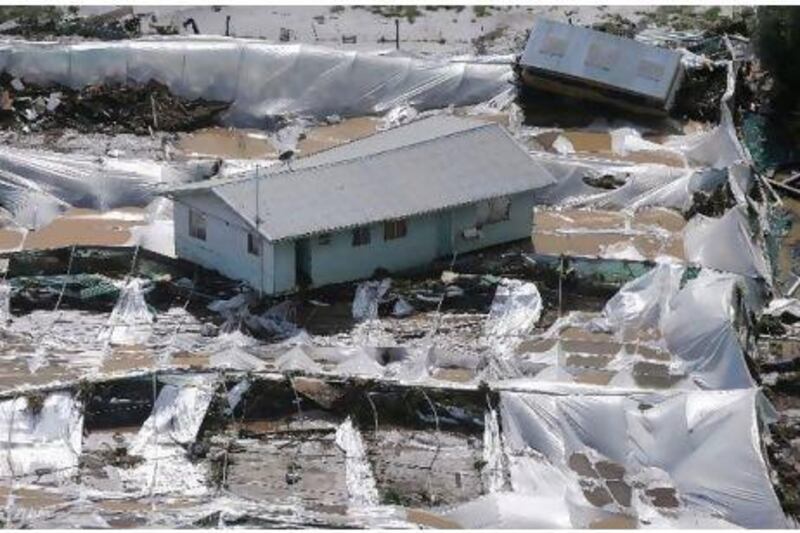GRANTHAM // When a freak storm triggered flash floods that sent a wall of water through her small Queensland town, Lesley Johnson raced down to the railway bridge. A human chain had formed, with people frantically passing children over the top so they could reach higher ground.
Not everyone made it over before the rising waters engulfed the bridge. Those swept away by the torrent included a little girl, one of at least seven people who died in the town. Four days later, Ms Johnson still could not face going back to the bridge, just 100 metres from her home. As she walked towards it, she began to weep.
"All I can see is death," she said.
As the people of Brisbane began cleaning up this weekend following the worst inundation of the Queensland capital since 1974, 100 kilometres or so inland, Grantham and a clutch of neighbouring hamlets were struggling to comprehend the events that almost wiped them off the map.
Queensland had been flooding for weeks, with dozens of places isolated and swamped, but with the waters rising only gradually people had plenty of time to get out.
That situation changed on Monday, when a "super storm" dumped an estimated 60 millimetres of rain in one hour on the fertile Lockyer Valley, known as Brisbane's "salad bowl".
The floods struck without warning; residents were at home, or in their fields, or driving around. A tight-knit community of about 300 people, Grantham was worst hit. After visiting the town on Friday, the state premier, Anna Bligh, described it as the "absolute epicentre" of the natural disaster that has gripped Queensland since well before Christmas.
Martin Warburton, who runs the petrol station in Grantham, climbed onto his roof to escape what some later described as an "inland tsunami".
From that vantage point, he witnessed the power of the wave as it barrelled down the main street, carrying with it everything it encountered: pedestrians, cars, shipping containers, giant logs - even a house, ripped off its foundations, with people still inside it.
Mr Warburton, who is haunted by his inability to help, watched the house rush by. Children were screaming "help me, save me", he recalled, speaking at a relief centre set up in Grantham's primary school. Cars, too, passed by, their occupants clinging to the roofs, so close to him "you could see the fear in their faces". Then the cars disappeared under water. He also saw dead bodies.
This weekend the house - a wooden "Queenslander" built on stumps to allow air to circulate in the sticky climate - sits in a paddock, about a mile from its original site. Surrounding it is a wasted landscape of rubble and mud, dotted with the reminders of life before: a golf club, a fishing rod, a children's toy, a battered fridge.
There wasn't much to Grantham before the flood: just a few streets of houses, a general store, the petrol station, a pub and a newsagent.
The railway track, used only for freight, divides the low-lying eastern part of the town from the west. The west, which was built on higher ground, was untouched. The east looks as if someone has rampaged through with a giant wrecking ball. After being shown around Grantham - or what remains of it - Ms Bligh, who visited with the prime minister, Julia Gillard, noted "the way that the town has been literally picked up and turned around and deposited in fields and roads".
She said: "What I saw can only compare to a war zone or perhaps a cyclonic hurricane."
Police and army personnel were still pulling bodies out of wrecked houses, fields and creeks. Another body found on Friday brought the death toll from the Brisbane and the Lockyer Valley floods to 16. In Grantham, 12 people were still missing, according to official estimates, but locals believed the true figure was higher.
"I know more than 20 who lost their lives down there," said Ms Johnson, gesturing towards the mud-caked railway bridge, where dozens of cars ended up wedged.
Homeless residents were staying with relatives, or at evacuation centres in neighbouring towns, and have not yet been allowed back to view their damaged homes. With the main highway west of Brisbane under water all last week, the only access to Grantham - and other devastated small towns, including Murphys Creek, Spring Bluff and Postman's Ridge - was by air.
Ms Johnson cannot forget the image of cars being sucked into the swollen creek. "You can't sleep at night," she said. "You go to close your eyes and all you can see is those little kids [at the railway bridge]."
Grantham will be rebuilt, survivors said. But Mr Warburton knows of four families so traumatised by what happened to the town that they have vowed not to return even to salvage their possessions.
When the search for bodies had concluded, the healing process would begin, said Ms Johnson. "Then we can all grieve and mourn for those that we've lost."





